Sierra West combines action programming and deck building in an old west adventure through four different modes. The player with the most points at the end of the game is the winner.
Sierra West aims to transport players back to the early pioneering days in the Sierra Nevada mountain region of America. This is achieved with four thematically different puzzles, each offering a different gameplay variant. Apple Hill challenges players to collect apples for various purposes, which can be traded for other resources (stone, wood, food, and gold) or to move up one of five tracks, each offering their own rewards or bonus actions. Outlaws and Outposts gives players the opportunity to live out dreams of the OK Corral or Tombstone, as players try to hunt down and take out wild west villains who threaten the tranquillity of the western frontier. Gold Rush provides players the chance to mine for gold, as they race to fill up the most mine carts with their yellowed prize. Boats and Banjos allows a more peaceful pursuit as players can pan for minerals (stone and gold), or to catch and trade in fish for more resources to help them achieve the highest score.
Players begin with a player board and a deck of eight cards which are standard from mode to mode. One card, unique to the mode, is added to the starting hand. These nine cards are shuffled and placed face down, with the top three cards drawn. The cards will have a random assortment of icons allowing players to traverse a mountain made of cards in an effort to gain better action cards for their decks, resources, spots to complete actions (such as trapping animals to gain additional resources), and traps that may hinder their two workers from completing their paths. Many of these actions are consistent in all variations while others represent the unique interactions, resource manipulation, and action spaces for a specific mode.
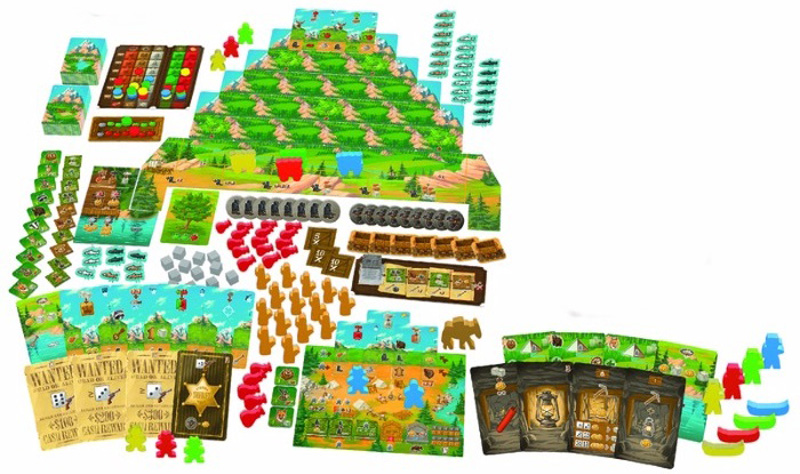
The three drawn cards are the tableau players are trying to carefully arrange to maximise movement, resource collection, and building. The player board is slotted in such a way that the cards will display only some of the icons (or sometimes no icons). Players will slot the left and right cards first and then slide the centre card underneath these cards to show only one icon in the middle of the player board. Players will then move their two meeples across these icons to complete actions and gather resources. There is some strategy involved with movement due to how icons are arranged within the player board and the costs of certain actions. The second icon on the bottom path will often contain an icon associated with an action. To complete the action, players will have to spend a resource. Similarly, the last icon on the bottom can provide another action opportunity that costs two resources.
Actions are vital in any Sierra West mode. While one mini-game is playing out on a player’s board, another is playing out on the shared mountain of face-down cards. Each player has a meeple at the base of the mountain. Each time one of their player board meeples lands on a boot icon, the mountain climbing meeple begins an ascent to the top of the mountain where the top cards are face up. These cards can only be gained when a player’s mountain meeple has made it to the card and one of the player’s board meeples has landed on the shovel action icon. By paying 1-2 resources, a player can then claim the card and add it to their deck. These cards will provide better actions specific to the mode’s goals and offer more opportunities to maximise movements and actions in upcoming turns. When a card is taken, the cards beneath that are no longer covered are turned face up and the race to climb the mountain to claim the cards begins anew.
The central board also offers another level of strategy beyond the continuous climbing of card mountain. Wagons placed on the left side of the board offer bonus scoring at the end of the game, and happen to utilise the same boot icons that allow players to climb the mountain. The difference is wagon movement also costs resources. As the wagon progresses across the prairie, the cost in moving forward grows along with it. The further right the wagon goes, the higher the multiplier on point bonuses at the end of the game.
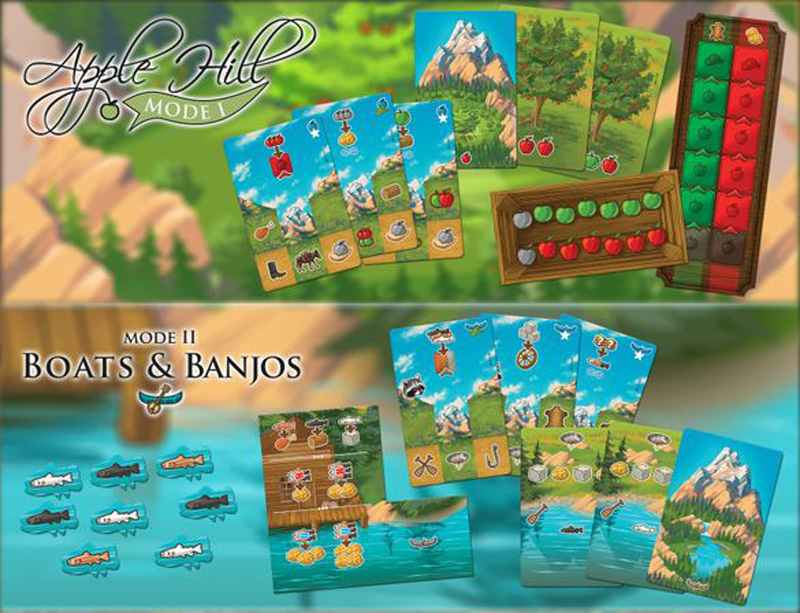
These wagons are tied to bonus actions on the cards at each player’s respective boards. Once the meeples on the player boards have finished their paths, bonus actions at the top of each card await for players who have the resources to fulfil them. These bonus actions allows players to either trade resources for gold (gold is the only resource to score at the end of the game) or to advance up one of the tracks available in the game. Advancement up a track not only gains players more points that can be multiplied by the wagon bonus, but they offer up resources with each gained level. They also can gift players the mule.
The mule is a de facto third meeple on a player’s board. He cannot traverse one of the paths travelled by the meeples, but he can complete one of the bonus actions on the top of a card. If a player has maximised their turn and resources, they may be able to complete all three of the bonus actions at their disposal. The mule is also valuable because he has the ability to turn gold into any resource, thus making gold a wild card, so long as the mule is in his respective cabin to perform this action.
Which brings us to the final aspect of the game: cabins. Each player board has five cabin spaces. Three of these spaces can be occupied by the regular citizen meeple, one by the ranching meeple, and one by the mule (if a player has the mule, which may be passed around between players). At the beginning of the game, cabin spaces will be worth negative three (-3) points per space. For players to gain cabin benefits (and also save themselves from losing three points), they may buy a cabin tile from the market by using an action icon from the cards (the same that allow players to get cards from the mountain). Cabin tiles may cost more than just the resource necessary to take the action depending on their location in the market.
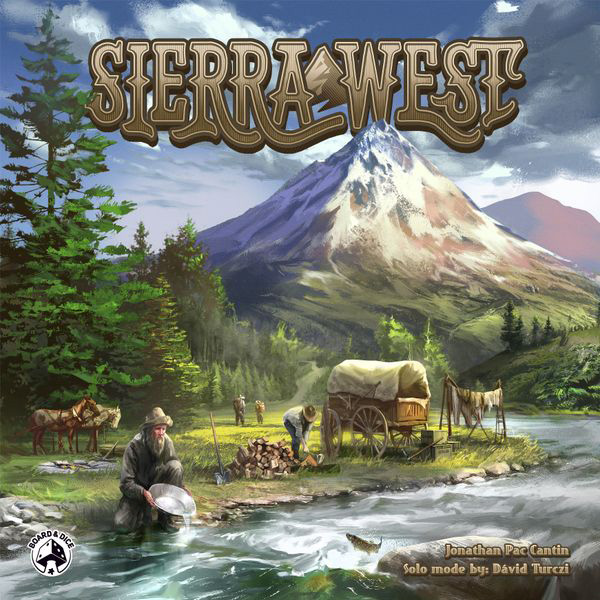
Yet cabins are one of the biggest pieces of the Sierra West puzzle. As the game progresses and players have some cabins at their disposal, they’ll be able to change the method and order their meeples travel across their paths. Coordinating when each meeple moves, which meeple is in a cabin, and which cabin they should be in to maximise every icon and action is crucial.
Cabins are not the only negative points within the game. Each player begins with five animals that can be trapped (four are the same throughout all modes, one is unique to each mode), allowing players to earn the associated resource for each turned over animal. Animals that are not trapped during the game will cost players 3 points per animal at the end of the game. However, trapping animals is an action that players can do when it is not their turn, benefiting from other players advancing up tracks. It can only happen once per round, and the meeple a player chooses to use to trap an animal (which will also cost a resource) will be unable to do a cabin action during the player’s next turn.
There is a lot going on in Sierra West, which will make it intimidating as players first begin to play. Managing movement on one’s player board as well as the shared mountain board, when to gain a resource, where to spend it, and what to gain is all about careful planning. Is it better to move up the mountain in a race to gain a card, or does advancing one’s wagon be more beneficial in the long run? As a deck begins to fill in with better cards, and as more actions and benefits become available, the game continues to evolve. Yet, reaching the 4x wagon multiplier could provide a lot of points at the end of the game if a player has advanced on each of the tracks. This is largely remedied in the scoring, which remains unchanged from mode to mode.
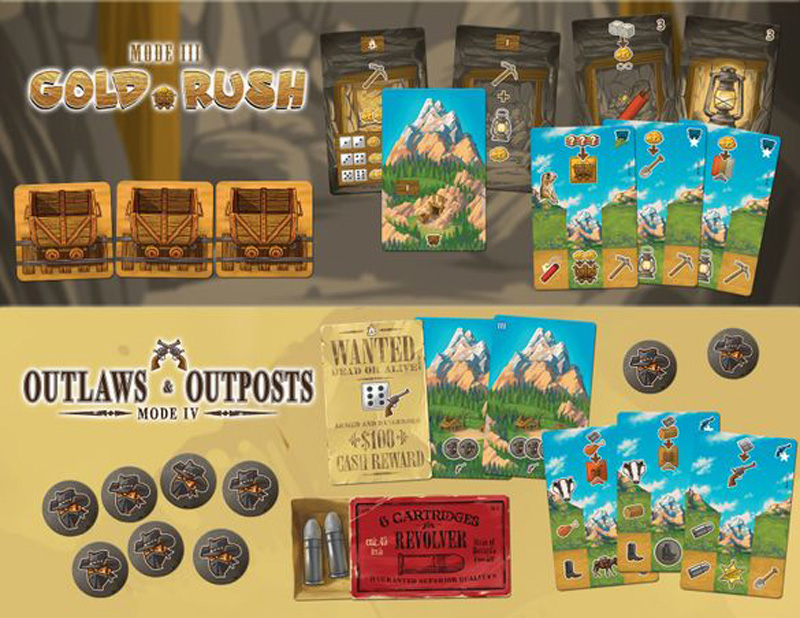
There is a solo option in Sierra West complete with an Automa deck. Dubbed Hastings–named after the guide of the Donner Party who met their fateful demise in the Sierra Nevada mountains–the AI opponent is easy to control and actually makes a great teaching tool to learn the game. However, once players have become comfortable with the machinations of the game and begin to unravel the puzzle, Hastings no longer feels like a formidable opponent and more like its namesake, leading his pioneers meeples into certain doom.
The unique interface combining elements of worker placement, action selection, and deck building lends Sierra West its gameplay gravitas despite the playful art and tongue-in-cheek modes. Once players become comfortable managing the core movements and action programming, the changes from mode to mode in the base game do not disturb those habits but rather build upon them. The game is also ready-made for additional modes (designer Johnny Pac Cantin has already hinted at an upcoming expansion including a mode inspired by the Donner Party’s ill-fated trip west) that will only enrich and enhance an already adventurous base game.
Sierra West is designed by Johnny Pac Cantin and published by Board and Dice. The game launched at Gen Con 2019.


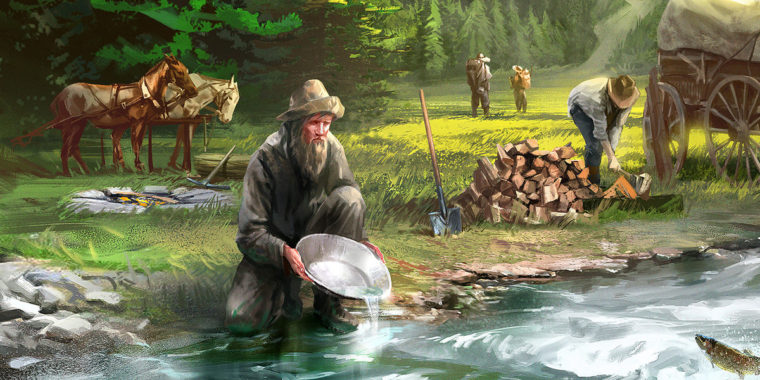


Thanks for the review.
I.m 5 plays in, and have to admit it took the first 3 games to realise the game strategy. The cheesy art and American settlers theme could give you the expectation of a family-weight game, but there is certainly more to it than meets the eye.
If someone is interested in picking up this game, be sure to give it a few plays before passing judgement, as it’s somewhat unique combination of deck-building, multi-use cards and game modes needs a little getting used to.